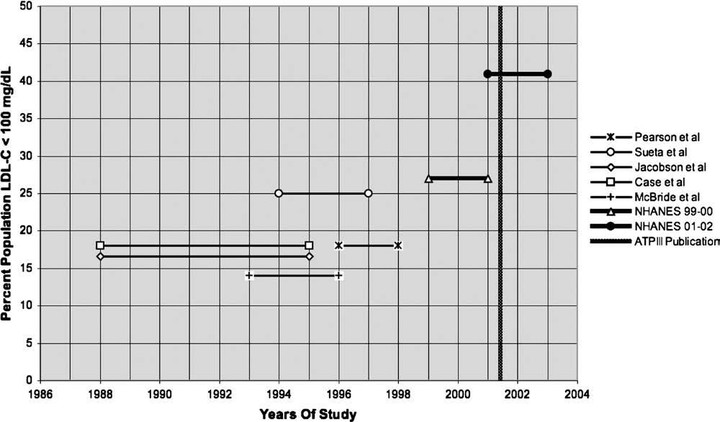National improvements in low-density lipoprotein cholesterol management of individuals at high coronary risk: National Health and Nutrition Examination Survey, 1999 to 2002

Abstract
BACKGROUND: This study sought to evaluate national levels of elevated low-density lipoprotein cholesterol (LDL-C) before and after publication of the Adult Treatment Panel III (ATP III). The ATP III guidelines intensified LDL-C targets and defined additional high-risk conditions. These recommendations are expected to have a noticeable impact on US cholesterol levels. METHODS: Coronary heart disease (CHD) risk was determined per ATP III guidelines for US residents aged 20 to 79 years in the 1999 to 2000 and 2001 to 2002 surveys. For those at high risk, the LDL-C mean percentage <100 mg/dL and percentage > or =130 mg/dL, although not taking lipid-lowering therapy, were compared between the 2 surveys. In addition, subsets with and without CHD were evaluated. RESULTS: Of all high-risk US residents, the mean LDL-C dropped from 129 mg/dL in 1999 to 2000 to 120 mg/dL in 2001 to 2002 (P = .003). Those <100 mg/dL increased from 23% to 32% (P = .003). Those > or =130 mg/dL and not on medication dropped from 36% to 27% (P = .001). Goal achievement and improvements were more favorable in the subset with CHD compared with those at high risk due to high-risk equivalent conditions. CONCLUSIONS: The sharp increase in high-risk US residents at the goal and the drop in the untreated percentage of those above treatment threshold illustrate national improvements in the management of LDL-C for those at high coronary risk. High-risk subjects without CHD displayed less significant improvements, suggesting an opportunity for better recognition and management of these individuals.